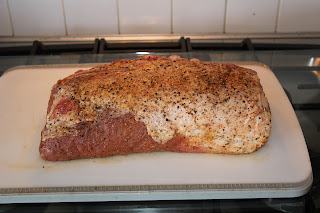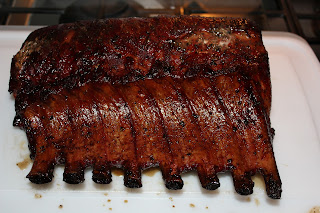Rack of Pork is a cut that is the pork equivalent of beefs prime rib. It has outstanding flavor and can be a real centerpiece for the table during the holidays or for special occasions. You may also see this cut presented as a crown pork roast which is achieved by taking two racks and forming them into a circle then tying the end ribs together. My wife and I have found it to be unmatched in flavor by any cut of chop, loin or tenderloin. This rack is 6.3 lbs which is rather large for this cut.
I will keep the dry rub simple as I will be putting a glaze on the rib roast in the last hour of cooking. I will lightly coat the roast with grape seed oil, put a nice dusting of Head Country rub and cracked black pepper. The dry rub has enough salt to prevent me from adding salt.
I will let the roast sit at room temperature for 20 minutes while the smoker comes up to temperature. We will be cooking at 220-230 degrees. The smoker will be burning lump charcoal and a mix of 70% apple and 30% cherry. This particular smoker requires a split of wood a little larger than a forearm every 30 to 45 minutes to maintain 225 degrees.
The internal temperature is up to 118 degrees. There has been a lot of publicity from the pork producers stating that pork can now be cooked to 145 degrees internal temperature and be safe for consumption. My wife and I prefer it between 150 and 155 so I will cook it to 150 and it should rise to 155 while resting.
I am making a glaze with 1 cup of Apple juice, 1/4 cup of Spiced Rum, 1/4 cup of Honey and 1/8 cup of Black Cherry Balsamic Vinegar. I will brush it on several times in the last hour of the cook. After two basting's the internal temperature is at 140.
Internal temperature @ 150 and it will rest for 15 minutes.
Pinot Noir breathing for dinner. This should be a very good pairing.
I'm very pleased with the end result. Tender, juicy, nice smoke ring and a very nice balance between the smokiness and the glaze.
I will have grilled asparagus and au gratin potatoes as my side dishes. My wife will have broccoli and au gratin potatoes.
It was a beautiful late winter day in the Kansas City area. The temperature reached the low 60's and it was bright and sunny. A perfect day to tend the smoker and enjoy the beginning of spring. I was very pleased with the outcome of the meal and look forward to a leftover chop in the days to come. I hope you enjoyed looking in and I look forward to my next cook.











